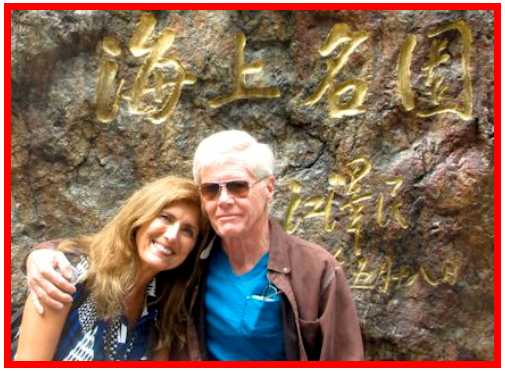
We Visit China and Tibet

May 5 - May 22 2015
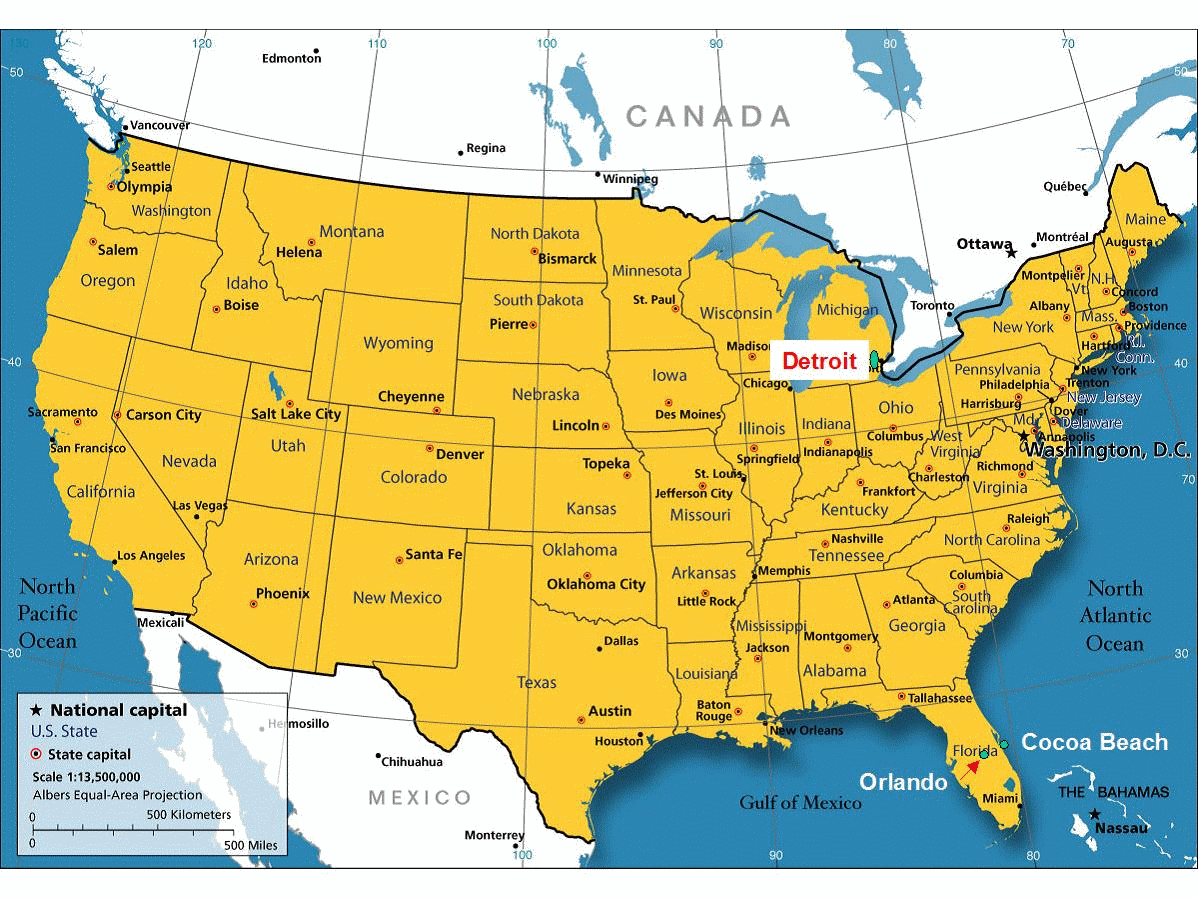



Before the pictures, first a few overview notes:
We found the people across China and Tibet to be most friendly and accommodating. Almost no one speaks English over there - including our guides for the most part, although the guides were far better at English than the host population in general. But we made do - as did they. Whenever we engaged someone with a simple "nee how." (phonetically the Chinese for "Hello.") all responded with a smile and a responding, happy appearing response. Curiously, small children seemed to be ALWAYS curious of my blond hair - OK! Blond heading to white. Often we were asked to have our picture taken with their children and the family.
The Chinese people, across the board, seem to be extremely proud of their children. Whenever you say "nee how" to their kids the parents light up with large smiles and are more than willing to have a pleasant interchange with you.
95% of the Chinese people are of "normal" height. "Normal" is defined as shorter than I. The other 5% seem to average about 6 feet, 27 inches in height.
Be certain to take a flashlight with you. Why? Because . . .
Back in the 50s when cars from England were very unreliable, the lack of reliability mainly came from their electronics. The company most responsible for their auto electronics was the Lucas company. Lucas had a nickname in those days: The Prince of Darkness. I believe Lucas did all of the lighting in China. No bulb we ran across seemed to have a wattage higher than 25 - 5 star hotel right down to the lowest of the low restaurants. Yes, the lights always worked but seeing anything at night was problematic.
We read a lot about the poor air quality in China - pollution in Beijing mostly, etc. We found this to be true across much of China except in Tibet and, surprisingly, Beijing. Both locations were pretty much crystal clear.
As an aside, China, in fact, includes Tibet - politically. So, I will use the term "China" to refer to both China and Tibet unless a specificity about Tibet is intended.
Our guides kept mentioning their "minority" populations - and, not in an unkind way. The vast majority of Chinese are "Han". What they describe as "minorities" may be likened to our Native American population. Here we have the Hopi, Cherokee, Comanche, Navajo, Apache, and the like. Hard to point out who's who by the majority of us. The same holds true for the Chinese "minorities" - except for the Tibetans. More on this later.
China is going through a massive "urbanization" and "modernization". The "old" is being replaced with the "new" - major construction can be seen everywhere. Their government seems to have a plan (according to our guides). They project where growth is likely or needed. They build the roads and infrastructure to support the growth. They "entice" business to move there while they put up literally hundreds of 30 story apartment buildings in each such location.
Unfortunately (to us anyway), except in Beijing and in Xi'an, the "new" seems to abandon the charm of the ancient architecture in favor of very tall, unadorned boxes. Efficient perhaps but not too very appealing to the eye. China has the appearance of having a very thin veneer of "First World" covering a massive "Third World" underbelly.
For certain, capitalism is alive and very well in China. One sees more Mercedes, Jaguars, Astons Martins, Cadillacs, Bentleys, etc., than one sees in Los Angeles, as an example. We saw no "clunker" cars - most were either new or in perfect condition. Apartments are small and costly. A 450 sq. ft. apartment in a larger city can easily run $250,000 US.
As with every other place we've traveled, both home and abroad, the people seem just fine - it's always the governments that are the problem.
Here, we hear about the Communistic, repressive government of China and how repressed their people are. We saw no evidence of that. No one seemed depressed or over burdened in the course of their daily lives. Of course, compared to the government here and our way of life, the China can't truly compare. But, there may be at least something positive to a somewhat repressive government:
When one walks about China one is absolutely safe. Apparently from the people there, street violence does not happen. Or, there are no repeat offenders, as it were. Is this 100%? Most likely not, as very few things are. But, we saw no evidence of "shady behavior" from anyone.
We saw not one policeman with a gun nor a single military person with a gun. Sure, there are traffic police about; but they handle traffic - nothing more.
Speaking of traffic -
Paraphrasing the oft misquoted "Gold Hat" from the 'Treasure of the Sierra Madre', "Traffic laws? We don't need no stinkin' traffic laws!" This seems to apply to one-way roads, divided roads, traffic lights, and even sidewalks. Be careful out there when walking! However, the one rule that seems to be followed strickly - no speeding. More on this traffic law thing as the narration continues with the pictures.
The vast majority of the tourists we encountered were Chinese. A conservative estimate is less than 50 "Westerners" were seen by us touring all of China. The only rude people we ran across were tourists from India - and this was from more than just one group. When we visited India we witnessed none of this - but, perhaps when they leave home they become less than "nice".
When out and about be sure to take some toilet paper (or, it's equivalent) with you. The restrooms, except in the major hotels, are, shall we say, less than modern in both facilities and "necessities". I think the Chinese forgot it was they who invented toilet paper.
Another "by the way" - if you plan on staying in touch with those back home electronically, it "ain't" as easy as you might guess. All forms of "social media" are blocked in China as well as all things related to Google - this means no "gmail". If you have an email from someplace other than Gmail you can receive from gmail and send to gmail but you can't originate an email from gmail. In total this means no facebook, youtube, twitter, instagram, and a whole host of other services. Also, even with an email that works, the pictures you take on a modern cell phone/camera are too large in size to transmit. So, plan ahead. You'll need an "app" that will reduce the storage size of any pictures before you can send 'em back home.
Oh, by the way, DO NOT DRINK ANY WATER THAT DOES NOT COME BOTTLED - A N Y W H E R E!!! Tea is fine, of course, because the water is boiled first. And, absolutely no soft drinks with ICE - ever.
One last thing: Be certain to take an extra razor or two. You can certainly buy a shaving razor over there. And, both Shick and Gillette are prominent. However, they must be seconds or thirds or something else because they work about as well as a butter knife purchased from the Dollar Tree.
---------------------------------
Now, on to a small sampling of the more than 1,850 photos we took and applicable narrations:
Our first stop was Shanghai. 25 million people live there. While there was evidence of lots of people here and there, by and large we kept asking ourselves, "Where are all the Chinese?" They weren't on the roads. And, they weren't on the streets. Very curious.
Shanghai is divided by the Bund Huangpu River into the "west side" and the "east side". The east side is totally new construction of massive modern buildings. The west side is mainly old, classic "British" architecture. This "British side" is the main financial center.
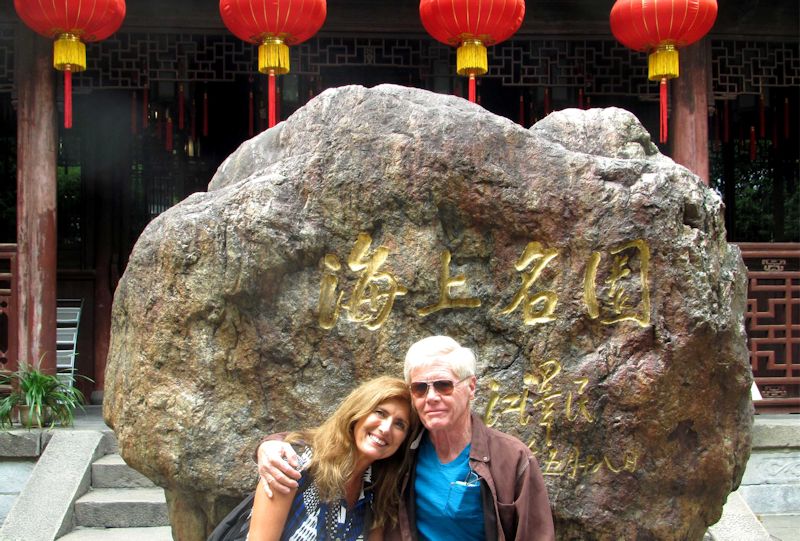
In Shanghai a street just for walking and shopping. Looks pretty crowded in this shot but it really wasn't.
On a whim we went strolling around the streets near our very nice hotel - all of our hotels were of very good quality. On one of our strolls we visited a meat processing facility. Or, how to become a vegetarian.
We found China to be an exceedingly clean country. There was never any evidence of litter anywhere. The floors, tables, "silverware", glasses, tea cups, bathrooms, everything was clean. This was true for their parks, streets - main walking areas, "back alleys" (we went to both), and roadways.
Shanghai can be a dangerous place at night. Not from crime - I explained that. And, not from cars - you can hear them coming. No, there is something else.
China must have 2 electric motor scooters and 2 electric bicycles for every person in the country. And, at night using lights would drain the battery; so, they don't. You can't hear them coming. Remember your Mommie telling you to look both ways before crossing a street. If you go to China - anywhere in China - remember her sage advice. They can come at you from the right, from the left, and from in front of you and from behind.
Now we are off to our second destination, Guilin. Our guide in Shanghai was from Guilin and expalined to us that she loved Guilin because it was a small town, very much unlike Shanghai.
So, with neither of us particularly favoring large cities, we were thrilled. So, we went there.
China has a wide variety of haute cuisine offerings from a wide variety of national choices.
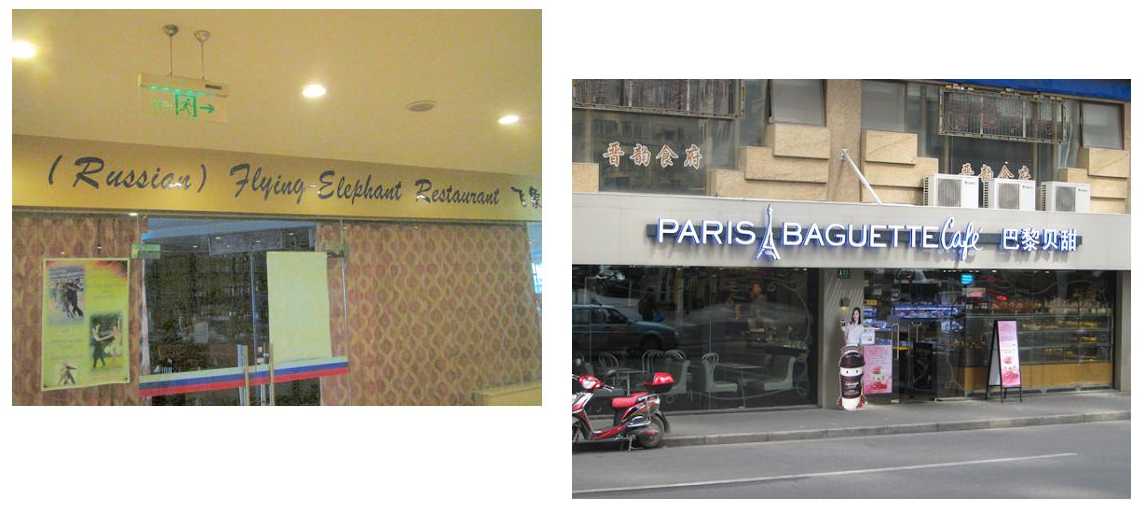
Actually, the restaurant food we had was very, very good. No, we did not venture to eating in the "open air" eating establishments - later you'll see a reason as to why not.
Some of things one thinks about China are Pandas and bamboo. Here is a picture from Shanghai where bamboo is used as scaffolding. We saw this use across China.

Now, the climb up and down was sort of strenuous but not all that hard - Unless one happens to be not inclined (or unable) to do the exercise. But, even in that case there's an "app" for that. Manys the time we had to step aside for 2 rather small Chinese men carrying some person up and down the mountain in one of these.

Here we have some coffee at the mountain top village overlooking the rice fields.
After the rice fields we headed back to Guilin.
In almost every city we visited there was park. Not just a small park; but one of enormous size where people could just relax & hang out. Most of these parks were as large as some of our smaller cities. Guilin was no exception.
Below are pictures from one of Guilin's parks. As one of its attractions this park has recreations of some of the world's bridges and monuments - the Golden Gate Bridge, the Arc de Triomphe, etc.
Sunset approaches in Guilin.
While still in Guilin we visited "Elephant Trunk Hill" - yet another park. There had been recent flooding and some of the small bridges were impassable. Also, there was another park adjacent to our hotel which featured small statues of animals, etc., just to heighten the feelings of serenity.
Me having a "pause that refreshes". One of Cyndy's many (obligatory) Coke sign photos.
Now, Yangshuo truly is a smallish city - about 30,000 people. It seemed to have the proper infrastructure to support such a population. However, they forgot one small thing.
They did not figure on the town having 20 million visitors per year. Now THIS was some traffic. And THIS is where we decided to go bicycling?????
But, first some pictures along the river.
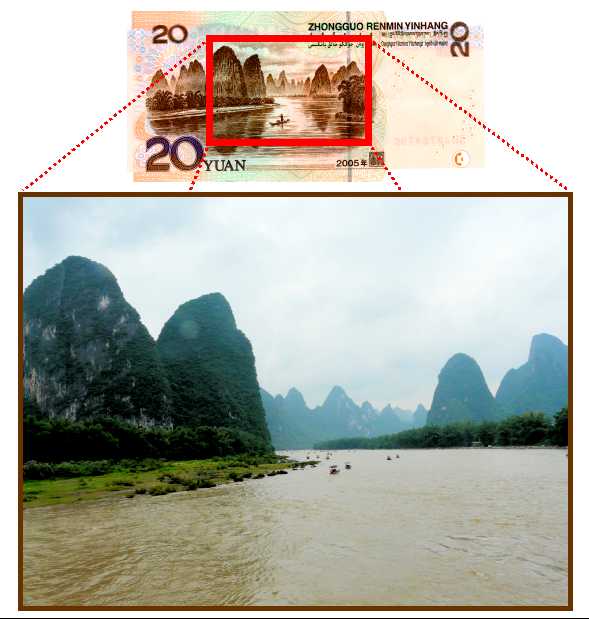
In the city part of our ride cars, busses, bikes, motorcycles, etc., were weaving in and out of traffic like mad people. It was a little scary at first, I will admit. Finally, we got to the countryside. Then all we had to worry about were cars, busses, bikes, motorcycles, etc., weaving in and out of traffic like mad people - but fewer of them.
It was actually a beautiful ride. Here are some pictures along the ride:
This is a mother and her child doing their wash the old fashioned way - in a stream using rocks. No joke!
The above picture of older buildings might illustrate the feelings in China of the "old" vs. the "new". It is not just the government insisting on "modernization". People have abandoned their old living spaces which were warm in the winter and cool in the summer to build fairly ugly, not very efficient but newer looking cinder block homes - leaving their old places "up for grabs". "Westerners" are coming in and buying the older properties and refurbishing them into "boutique hotels".
In the above shot one can see how the "country people" achieve transportation. No, they don't actually have cars and just choose to ride these bamboo rafts for fun. It's all they have. This is how they "get to the store". Mostly they farm for a living with their kids picking up extra money "in show business" - explanation to follow shortly.
The stage is the river on which we traveled earlier, the karsts serve as a backdrop, and the play has a cast of 600. The majority of the cast are children who farm during the day and do the play(s) at night. Amazing stuff, this.
Some scenes from the play:
In the above pic you can see the karsts lit up in the background. All the rest of the "lights" you see are people. Very large scale, this is.
If you would like to see a 3.5 minute excerpt of this play, Click Here. This clip will give a much better perspective on the size of this production than does a picture. As an aside, as you watch the video you will notice tons of "flashes" going off from cameras, cell phones, etc. Of course, taking any pictures or videos is "forbidden". So much for rule following - AGAIN! I love this place!
Anyway, there was a Chinese laundry about 2 blocks from the hotel. Imagine that! The cost $7 US. Seems the old "no tickie, no laundry" doesn't fly in Yangshuo. The young girl attending the laundry (she was about 10) indicated that she would remember us - no receipt necessary. The next morning we went to pick up our stuff. The young girl's mother was working and somehow recognized us right away. How did she know? Could it be that there were only about 6 other caucasians in town at that time? AWESOME!
We are ready to head back to Guilin to catch our flight to our next stop, Chengdu, to see the pandas. So, we do just that.
We are still waiting to see where all the Chinese people are. Catch this shot of the Chengdu airport while we wait for our luggage.

Above are all different pandas. I can't tell them apart. Cyndy now knows each by name. Independent of all that, they are REALLY cute.
This is the titular home of the Dalai Lama. He, of course, is in "exile" and now lives in India.
At the outset of the 1959 Tibetan uprising, fearing for his life, the Dalai Lama and his retinue fled Tibet with the help of the CIA's Special Activities Division, crossing into India on 30 March 1959.
Traveling to Tibet is interesting. One has to have special "papers" to go from China-proper into Tibet. There are still "hard feelings" between Tibetans and the Chinese government - apparently.
Also, Lhasa is at 12,850 feet. This means the amount of oxygen available when you take a breath is only about 90% of that at sea level when a person is "at rest". A 10% drop doesn't sound like much - BUT IT IS - because you won't be "at rest". Just sitting is fine. But, try walking up even a small flight of stairs and you'll feel like you just climbed Mt. Everest.
So, before treking up some many, many steep steps (355 of 'em to be exact) to visit the Potala Palace (Buddhist religious and governmental headquarters of Tibet) you would be advised to rest a bunch beforehand, breathe deeply, and go slowly.
We visited both the palace and a Buddhist Temple. Both have much the same things inside - lots of statues of Buddha and tombs of past Dalai Lamas. Photos of the insides are not allowed - really not allowed.
The palace seems unchanged from 1,000 years ago - very narrow "hallways", very dimly lit, with no air filtration or air movement capabilities. Very stuffy. It feels like there are millennia-old dust particles just hanging in the air. Lighting is provided by a thin overhead wire with low wattage bulbs about every 30 feet or so. Hard to really see inside.
The outside walls are painted both red and white. The entire structure must be painted once a year - mainly the white parts. Curiously, the white paint is made from some earthy materials mixed with MILK for color. Not very durable.
These buildings are like a hoarders' dream come true. Every place you look is crammed with statues and other artifacts.
The floors are "without a spot" clean - the air not so much. The Buddhist Monks continually sweep the floors with ancient brooms just like one sees in movies of olden times in China:

Potala Palace:
When traversing the narrow and dimly lit passages within the palace (it's like a maze in there), about every 20 feet or so are niches in the walls. Here monks are scrunched up in the niches reading Buddhist scrolls, etc. In one of these niches I noticed a monk "doing his thing". But, you could see the light of his cell phone coming from behind his robes. I guess reading scrolls is not all that they do.
It occurred to me that the Tibetans strongly resembled Native Americans and Native South Americans. So, I looked it up. There is yet no proof that there is a link between the two peoples. However, when the Dalai Lama visited a Hopi tribe in the US, the Hopi chief welcomed the Dalai Lama "home".
Turns out there is a Native American tradition that their ancestors were from the Tibetan region - again, no proof (yet) that they actually were.
Check out this picture and see what you think.
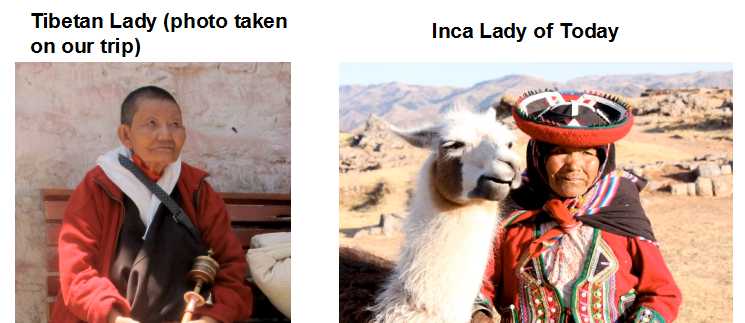
We leave Tibet and head to Xi'an - home of the Terracotta Warriors.
These truly are magnificent. To date there are 3 "pits" with terracotta warriors and their horses being excavated. The first, and largest, seems to be only about 50% excavated. The other 2 sites seem at about the same degree of excavation.
The farmer who originally stumbled upon this site in 1974 is there every day signing books. A picture of him is shown below.
Rather than disturb these sites for visitors, the Chinese just built huge buildings around the sites leaving the archaeologists able to continue their work undisturbed.
From what we had read we were expecting very large crowds. We were led to believe that you would have only a few seconds to a minute to view the site due to the movement of the large crowds. This was not true in our case. There were some large tour groups (2 or 3 numbering about 20 people each), but we had pretty much free access to stay as long as we wished and view as much as we desired.
The founding farmer
For an interesting anecdote about a visitor to the Terracotta Warriors, Click Here.
Xi'an is surrounded by a city wall about 10 miles in total length. We took a walk along the top of the wall - NOT the whole distance. The top of the wall, as you can see, is very, very wide.
As we've flown everywhere in China so far, we thought it might be fun to take the "bullet train" from Xi'an to Beijing. So, we did.
This baby clips along at an average of a little better than 185mph. And, the ride? Smooth as glass. It takes a little over 5 hours to reach Beijing - but, it was worth the ride. (NOTE: we were told to make certain we rode in the 1st class section - which we did. Very comfortable.) Remember my comments on China being very clean. On the bullet train, after every stop (there were only 3 very short ones), the floors are wet mopped for cleanliness.
The Lobby of the Novotel Hotel

Our first visit in Beijing was to the Forbidden City and Tian'anmen Square. They are located side-by-side. Both of these were disappointments to us.
Both are VERY large places. I guess I had too great of an expectation from movies, etc. BUT, we found out, finally, where all the Chinese people were. Right where we were at that moment. Man, what a crowd.
The above building is where Mao's tomb is located. Our guide informed us that people stand in line for over 2 hours just to get a 2 second glimpse of his body. And, the line of people waiting to do this never stops.
Above - The entrance to the Forbidden City
Below - scenes from inside the Forbidden City
We just loved this guy!
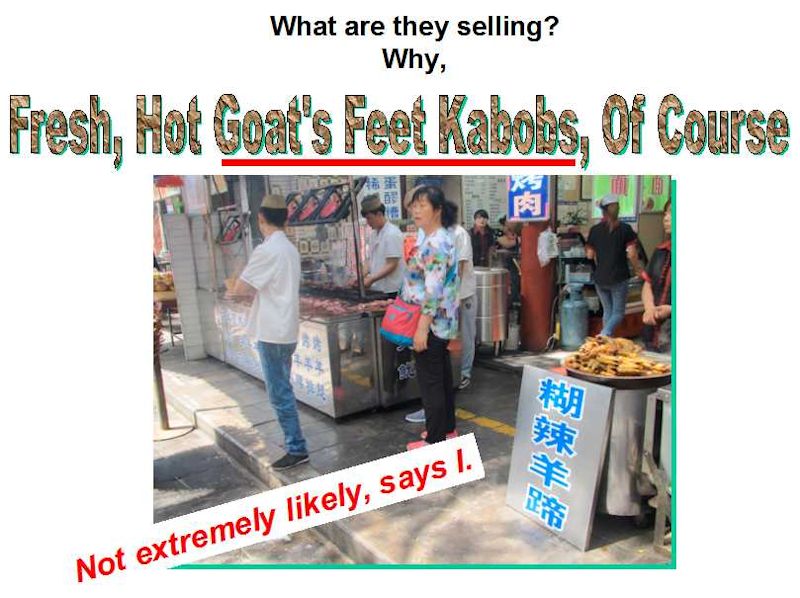
This really is a marble boat. And, no, it doesn't float.
Now, it is a giant park meant for contemplation and relaxation.
The Great Wall of China actually is GREAT. Close to Beijing, there are 3 choices of where to see it. First, there's a place close to city center. This is the most "touristy" - not for us. The third location is far from town, gets the least amount of visitors (this is good), but isn't in the greatest state of repair. The second spot, the one we chose, has few tourists, is in good repair, and is only a 1.5 hours drive from our hotel.
To give you an idea of just how big Beijing is geographically, after the 1.5 hours drive on a 70mph highway we were still technically in the city of Beijing.
Navigating the "Wall" requires a big desire to climb steep slopes and steps - that's after you get to the top of the Wall.
You can take the steps to get up there but we chose to use the tram. I know - WHIMPS!! YEP! That's us!
Anyway, enjoy the pics:
The Tram Up & Down.
Gives an idea of how steep these steps are.
As an aside, just before this picture was taken, we saw a woman "doing the wall" in a pair of high heels.
LOVED EVERY MINUTE OF THE TRIP!
If you are old enough, you probably remember your mother telling you to eat all your supper. "There are starving children in China, you know."
Well, that was a true assessment. And, here's why.
The following occurred over several decades:
Back when the Communist revolution took place in China (1949) and Mao took over, he (and his government) wanted real socialism. This meant that everyone (except the "elites", of course) should earn the same pay. He wanted to have a "redistribution of the wealth" in China.
Back then the vast majority of Chinese were farmers - many still are today. Anyway, Mao, who now owned ALL property, allotted an equal amount of land to every farmer. He didn't "give" them the land, he just let them use it. Each farmer received the same pay - whether they worked hard or not.
Pretty soon the industrious farmers saw that the lazy ones were getting the same rewards as they. So, the industrious farmers stopped working. They didn't exactly "go on strike" - they just acted the same as the lazy farmers.
It wasn't long before famine ensued across China. And, there really were "starving children in China".
Of course it wasn't quite as simple as all that. Click Here for a none too appetizing look into Mao Zedong's "activities" during the period. Mao is reputed to have been the greatest mass murderer in the history of the world. Mao's slogan for his Communistic approach, "The Great Leap Forward." (like many who have used the word "Forward" in their slogans) didn't exactly have the best outcome.
Well, it didn't take too very long before Mao and the government said, "Hold on a moment! This isn't exactly working out as we thought it would."
So, they revised the "plan". What they did then was to actually GIVE the land to the farmers and told them that their pay would be based on what they produced.
After some more time, the industrious farmers were producing like crazy and the lazy ones were, well, still lazy. The lazy farmers either sold or leased their land to the industrious ones - AND, capitalism in China was off and running even though China was/is a communistic country.
The famine disappeared, of course.
True and full socialism has never worked and it never will. The Chinese are living proof.